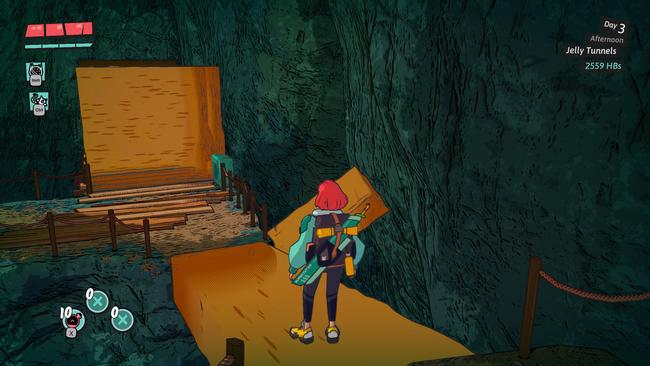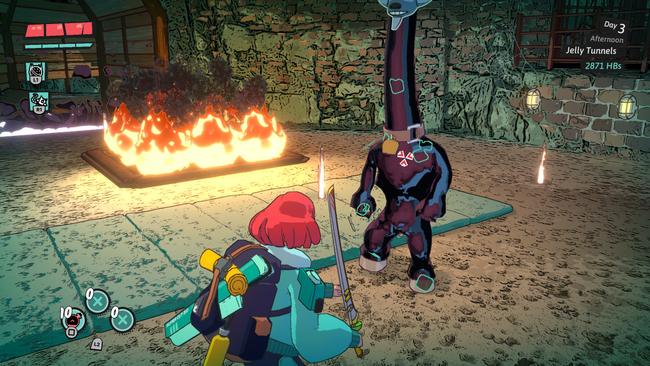
Dungeons of Hinterberg Review
Dungeons of Hinterberg scratched an itch that has been lacking in many RPGs lately. Its title exactly reflects the heart of what this game does best - dungeons. With over twenty unique dungeons that are all cleverly and tightly designed, this debut title from developer Microbird Games had a clear vision, and they successfully delivered on it.

Players go on a vacation in the delightful Austrian town of Hinterberg through the eyes of Luisa. She’s grown weary of her career at a law firm and has decided to embark on a change of pace. Mysterious magical dungeons populated several regions surrounding Hinterberg, so its administration, of course, has commercialized them as tourist attractions. Curious individuals around the world now flock to Hinterberg to become slayers, which are adventurers who are determined to complete all the dungeons.
While I think it spends too much time on tutorials in its first couple of hours, there’s a comforting simplicity to Dungeons of Hinterberg once it lets players have full control of Luisa’s day-to-day schedule. Once a new in-game day begins, people travel to one of four regions. They can freely run around them searching for a new dungeon to complete, or simply relax at a local spot to take in the scenery for some minor stat boosts.
One of the most clever design decisions in this game is the two magical spells available on a per-region basis. Upon visiting each of the four areas outside of Hinterberg for the first time, people should visit that map’s magic shrine to unlock new spells, which only work within that region alone and nowhere else. This allows the developers to give each area and its dungeons a unique feel and identity.

For instance, the first region grants Luisa both a huge iron ball she can detonate and an extendable ball-and-chain device. Every dungeon in that area utilizes these two spells in different ways in order to navigate through them, such as manipulating jelly platforms with the ball-and-chain to activate different pathways.
Meanwhile, the next area gives players a tornado that Luisa can ride, along with a gust of wind projectile. Riding the tornado elevates Luisa, so she can safely travel through low-lying hazardous areas, but some dungeons may require this ability to go past gated areas and activate some sort of switch. The projectile, on the other hand, allows Luisa to interact with a ranged lever to enable other mechanics in a dungeon.
Dungeons of Hinterberg is equally a puzzle platformer as it is an action RPG. Every dungeon intuitively teaches players the common mechanics and systems that they’ll be engaging with. Some of these levels may alter the player’s perspective at times by turning the usual third-person perspective now either isometric or a sidescroller. Ultimately, the game does a great job teaching the fundamentals of how Luisa’s magical abilities can interact with the environment organically.

It was challenging to wrap my head around how there is no manual jump button. Luisa will automatically take a leap when she runs off a ledge, so this led to some rare finicky moments where I wasn’t grasping the intended solution to a puzzle. While I initially disagreed with the lack of a jump button, its deliberate absence allowed Microbird Games to create some creative dungeon layouts that were constructed to keep this limitation in mind.
None of the dungeons and their puzzles are overwhelmingly difficult, though there were a few later ones that had me scratching my head quite a bit. I greatly appreciated that Dungeons of Hinterberg doesn't have a sidekick character that yaps about where to go or what to do next if I was stuck on a puzzle for more than thirty seconds. Instead, the game is perfectly content in letting me take my time in solving my current roadblock at my own pace. It’s an odd thing to admire, because this was the standard for many older titles, but a lot of modern games have truly become too scared of having their players figure out something on their own.
Although the dungeons are linear for the most part in Dungeons of Hinterberg, there are still opportunities to open up optional routes that may lead to a treasure chest. Some areas inside certain dungeons will have wider open spaces to travel around, but it usually serves to activate multiple switches to open up a door or route to move forward. Once Luisa reaches the end of a dungeon, she has to go up to a nearby podium by the exit to stamp her completion of it before exiting.

Whether Luisa decides to tackle a dungeon or chill out admiring the scenery, she returns to Hinterberg in the evening. Players can then decide if they want to raise Luisa’s relationship with someone or enjoy a solo activity that ostensibly serves the same function as a scenic spot. Before that, they can stock up on items and buy new equipment before choosing to engage in something that passes the time.
There’s a handful of NPCs that Luisa can befriend. Each of them possesses multiple relationship levels that reward some sort of benefit to the players, such as increasing max HP/MP, a new attack conduit skill, or expanding Luisa’s capabilities like opening locked treasure chests. Several characters need Luisa to reach a certain threshold in her renown, familiarity, amusement, or relaxation social stats before players can even begin interacting with them.
Raising social stats feeds into Luisa’s combat capabilities, because some equipment will arbitrarily have reduced stats until one of her social stats reaches a certain number. This restriction annoyed me at first, though these thresholds eventually became trivial as I played more.

Numerical stats for attack and defense power do play an important role because these determine what “level” Luisa’s offensive and defensive capabilities are. Each dungeon is assigned a numerical difficulty rating. While players are free to challenge dungeons that have a considerably higher rating than what their Luisa is equipped with, the stat scaling may make the combat encounters in them more frustrating or time-consuming. This serves as another intuitive method to convey the intended difficulty progression, though the game has no issue if players want to traverse what it has to offer in a more unconventional manner.
Combat in Dungeons of Hinterberg carries a similar approach to the game’s other elements - simple, but effective. It admittedly takes a bit of time to become interesting as Luisa is only armed with a sword and her region-exclusive spells in the initial hours. Magic can be utilized freely outside of combat, but will begin to consume MP in battles. Light and heavy attacks can recharge MP to compensate. There is no stamina meter to dictate how many attacks a person should commit; the closest thing to one is allocated exclusively for dodge rolling.

Battle cadence mostly boils down to proper positioning and being mindful of how to approach an enemy mob. Later combat encounters will involve more threatening enemy types that can dish out a lot of damage, especially if Luisa is undergeared. I wish the flow of combat was a bit more snappy because Luisa’s animations can come off sluggish or muddy at times. The lock-on is often unreliable in more populated fights as well, due to how the camera movement can whiplash on certain angles.
I felt that combat started to become more engaging after unlocking attack conduits and charms for Luisa. Up to three attack conduit skills can be equipped onto Luisa and have a cooldown till they can be used again. Charms are modifiers that have various effects, such as attack conduit cooldown reduction, firing off a shockwave when a foe is slain, providing a multiplicative increase on attack, attack conduits recharging MP, and such.
Luisa has a set number of slots in which charms can be set into, and some charms can take up multiple slots. Eventually, players can unlock the ability to reduce the number of slots that a charm consumes with various materials. This opens up various character-building opportunities to spice up combat, such as stacking multiple cooldown reduction charms to continually fire off attack conduits. I had Luisa achieve a satisfying balance of rotating between magic spells, attack conduits, and basic attacks to recharge resources that continually assaulted foes.

In my previous hands-on preview with Dungeons of Hinterberg at last year’s PAX West, I learned that the enemies were based off of Austrian mythology. While there are several enemy types with different body shapes and sizes, almost all the enemies’ bodies consisted of black magical gunk that wore a different mask. Only a few gigantic region bosses had unique designs that extended throughout their entire structure.
This feels like a missed opportunity to further showcase the expressiveness of creatures in Austrian legends because it contrasts so harshly with the utterly beautiful environments in Dungeons of Hinterberg. It is filled with varying color palettes that are all vivid and vibrant thanks to the cel-shading throughout its art direction. There’s a certain harshness to the outlined edges of the environments that help them pop out.
Its presentation style does have a few setbacks though, such as how the pronounced edges of dialogue boxes make their aliasing noticeably irritating. Several face models also reminded me of Nintendo's Miis, and I don’t know if that’s a good or bad thing.

There is an overarching story in Dungeons of Hinterberg that’s predictable, but it gets the job done. I wouldn’t say that the narrative is bad; it merely exists and I have no strong feelings about it. The overall cast has some amusing characters, though none of them strongly resonated with me. I considered the gameplay reward as my guiding principle on who to hang out with at any given time, more so than any genuine interest in getting to know each of them individually.
Some aspects of the game may allude to a bad end at its final stretch, but I’m personally not sure if there is any sort of time limit or trigger in Dungeons of Hinterberg that actually leads to one, if it exists. In the world of this game, slayers mention a challenge of beating all 25 dungeons in 25 days that’s never been done before - so I did that, and I’m not sure if that led to what would be considered a true end or if that was always going to be the default ending. Even when I loaded up previous saves to go beyond that point and activated what seemed like a time-sensitive sequence to incentivize me to rush to the end, a “bad end” never arrived no matter how many in-game days passed by. For whatever it’s worth, my initial playthrough lasted me roughly 18 hours.

Microbird Games delivered a strong debut project with Dungeons of Hinterberg. While limitations to maneuverability may seem off-putting at first, its numerous dungeons have been carefully designed to utilize different magical spells’ environmental interactions to traverse them. There are some understandable design constraints, such as a lack of variety in its enemy designs, that help illustrate where Microbird Games’ priorities lie - and there’s a beauty in that. This is a development team that had a clear vision in what they wanted to achieve with Dungeons of Hinterberg and I think they succeeded brilliantly.